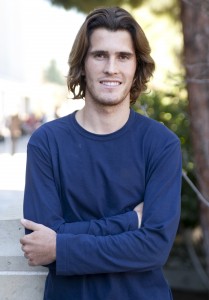
But for third-year Design | Media Arts student Canon Call, it is worth more than its monetary value – the abandoned Lincoln could be transformed into an Obama illustration worthy of artistic accolade.
Starting tonight and lasting until Jan. 31, Call’s artwork will be displayed in the Design | Media Arts department’s UV/UG Undergraduate Exhibition – a name that represents the energy of ultraviolet light – taking place in the New Wight Gallery. This exhibition will showcase Design | Media Arts students who have been selected for their innovation, technical ability, strong conceptual ideas and liveliness.
Call’s installations range from acrylic work to illustrations. In one piece titled “Barack for Chanel N˚5,” he transformed Lincoln’s face on the five-dollar bill into an illustration of President Obama. Inspiration for this piece came when Call arrived at the Beverly Hills Hotel to cast his vote in the presidential election.
“As soon as I got there I saw a woman illegally park her Bentley and spray on perfume really quick, which was so strange,” Call said. “I just happened to have a five in my pocket.”
Call said it was the woman’s odd behavior that first caught his eye: Why was she applying perfume at the polling place? Wearing perfume would not affect the election in any way. After beginning his illustration at the scene, Call was inspired to finish the pieces when he returned home.
This illustration – as well as Call’s other pieces in the exhibition – was initially created for a class project for Design | Media Arts professor Rebeca Méndez. The project partnered with the Hammer Museum, and students were asked to read five articles from the museum’s catalog about the exhibition “Graphic Design: Now in Production.” Then they were asked to choose a single word that would inspire a quarter-long project.
Using graphic designer Ellen Lupton’s article, “The Designer as Producer,” Call chose to have his project revolve around the word “produce.” Call said that unlike words like “manufacture,” which have social connotations, “produce” has a variety of definitions that allowed limitless boundaries for his project.
“Produce could even mean going to the grocery store and buying vegetables, or creating life or thoughts – anything,” Call said.
For his project, Call chose to embody the word “produce” by producing a new artwork each day. Call said that through this project, he has learned he does not need a master plan from the beginning. As long as he focuses on the creative process, a project will reveal itself.
“In the middle (of his project) I think he may have been worried about running out of ideas, but it pushed him to keep creating and finding inspiration,” said Design | Media Arts graduate student Phoebe Hui, Call’s teaching assistant in Mendez’s class.
Even though Call had minimal time to complete each piece of art, Mendez said it did not hinder his ability to create. She said the short deadlines pushed him to think on his feet.
“Nature doesn’t stop to think of what the next step in evolution is, it just becomes,” Mendez said. “(Call’s) ideas have a quickness to them, a wittiness and provisional aspect.”
Constrained by time, Call said he was suddenly inspired to illustrate conceptual artist John Baldessari as a Yeti. Titled “John BaldeYeti,” this installation is a clever, tongue-in-cheek illustration of Baldessari on Gucci and Hermès magazine advertisements.
Like “Barack for Chanel N˚5,” this illustration also has inspiration rooted in fashion. Call said he enjoys reappropriating and poking fun at fashion advertorials, even though they are often very serious, with lots of money involved.
“I would rather look at something that makes me laugh than something that tries to make me feel bad about myself – ads that tell me how I should look,” Call said.
Mendez said that Call’s artwork reacts to the environment around him. She said that advertisements attempt to influence consumers’ identities, but Call speaks back in a perceptive way.
Like Call’s observation of the ritzy woman at the polling place, she said the way he finds inspiration and thinks of ideas is extremely playful and imaginative – without boundaries of what should or should not be included in his works.
“That is a child’s mind,” Mendez said. “In a child’s mind, anything is possible. (Call’s work) is beautiful in the sense of possibility.”
Email Komoto at kkomoto@media.ucla.edu
[media-credit name=”Courtesy of Canon Call” align=”alignright” width=”300″].
